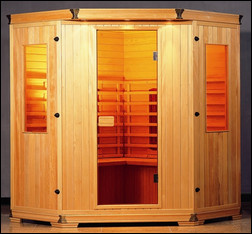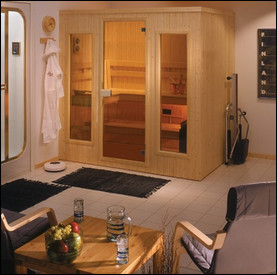For many years, the only place you’d find a sauna was at your local health club. But today, in-home saunas are growing in popularity as people want to enjoy their benefits in private and on their own schedule.
 The Finnleo Sisu Sauna is a traditional sauna that can be custom designed to any specification. |
Two factors are fueling this surge in demand: the ease of in-home installation and sauna’s purported health benefits. Installing a sauna is a relatively easy do-it-yourself job. Small one- and two-seater models that can easily fit in a bedroom or basement can be installed by one person in little more than an hour. One-person saunas can be as small as 3 x 3 x 6 feet or can be custom built to any size.
Installation is really easy, says Scott White of his four-person, far-infrared sauna, which sits in the corner of his bedroom. “It basically came in five pieces and it just snaps together. You connect the wires and you are pretty much good to go.” White did have to hire an electrician to install a 220-volt electrical receptacle, but he did the rest of the work himself.
The health benefits of saunas are increasing consumer interest and sales, which have been rising about 10 percent a year according to Finnleo Saunas of Cokato, Minn, a leading manufacturer and distributor. When entering a sauna, the goal is to work up an intense sweat—which is heralded for everything from arthritis relief to autism treatment via detoxification to weight loss. A recent, although small, study in the Journal of Clinical Rheumatology of sauna’s effect on rheumatoid arthritis symptoms showed improvements in pain, stiffness and energy level in people using infrared saunas regularly. Harvard Men’s Health Watch reports that asthmatics experience less wheezing and symptoms abate for psoriasis sufferers after sauna use. But many of the other health claims, specifically regarding detoxification of heavy metals, have never been subject to intense scientific study.
White, who is a personal trainer in Scottsdale, Ariz., invested in a sauna because he believes it helps the muscles recover after a workout. And by the way he falls asleep so easily after a good sweat in the sauna, he knows it aids in relaxation. “I think it boosts the immune system,” White says. “It helps your body just totally cool out.”
If you decide to install a sauna, the major decision you’ll have to make is between the two leading types available: far-infrared or traditional. Here’s a primer on both.
Traditional Sauna
Traditional saunas are modeled on the design used for centuries in Finland where these hot rooms are used regularly by one-third of the population. Inside the sauna, there is a small rectangular heating unit, on top of which are several
rocks that help heat the room to as high as 175 degrees. Rooms can be custom-ordered to any specifications. Nordic white spruce, cedar and hemlock are popular woods used in their construction.
Regardless of size, assembly is still quite simple, says Tracy Felder, research and development and quality manager for Finnleo Saunas, the nation’s largest traditional sauna company. “You put down a base rail,” he says. “Then you’re
 The three-person SaunaGen Far-Infrared Sauna comes equipped with a CD player and color therapy light system to increase your relaxation. |
going to take the wall panels and set them on that rail and run a couple screws together. That whole wall is now a solid piece and you just build your room. Our custom-cut saunas and our panel-built saunas are very much a do-it-yourselfer type program.”
Traditional saunas heat the air and make it very dry. Humidity can be increased by pouring water on the rocks. No water results in a very dry heat; a lot of water can produce a steam room effect.
How long you stay in a traditional sauna depends on how hot you like it and how well you tolerate the heat. “If you run your traditional sauna at 140 degrees, you can stay in there 15 to 20 minutes,” says Felder, whose company sells both traditional and far-infrared models. “It it’s at 170 and running 10 to 15 percent humidity, you may only stay in there five to 10 minutes. With an infrared sauna, since it runs at a lower temperature, you typically can stay in longer.”
Far-Infrared Sauna
Far-infrared saunas use a form of energy that can penetrate the skin, warming you directly and bringing on an intense sweat. Because they accomplish this at lower temperatures than a traditional sauna, far-infrared is a good choice for those who don’t want an intense heat experience, who have breathing problems or just don’t enjoy a high-humidity, steam-like atmosphere you can get in a traditional sauna.
SaunaGen, an industry leader in far-infrared saunas, constructs its saunas out of hemlock fir wood. Instead of rocks, ceramic heaters warm the room. Far-infrared models heat up in as little as 10 minutes. Finnish-style saunas usually run much hotter and because of that can take two to three times as long to reach the optimal temperature.
Like small traditional saunas, far-infrared models are a simple do-it-yourself assembly job. They are growing in popularity because they are less expensive than traditional saunas and use less energy, making them cost less to run. “In the far-infrared sauna, you’re not exhausted or fatigued because it’s not terribly hot in there,” says Diane Doletzky, owner of Paradise Sauna in Wixom, Mich. “You perspire for 20 to 30 minutes. I break a sweat at 103 degrees. And to get the most out of your sauna session, you should be sitting in it at the temperature which you break a sweat.”
Choosing the Right Sauna
Finnleo sells both traditional and far-infrared saunas. The model you choose often comes down to your expectation of the sauna experience, says Felder. If you want a high-heat experience with humidity where you stay in the sauna a short period of time until you feel hot, a traditional sauna might be for you. If you’re more interested in relaxing, maybe even reading a book, while spending 30 minutes sweating in a heated room, then far-infrared will meet your needs. “It really comes down to a personal choice,” says Felder.
Credit: Renovate Your World




























